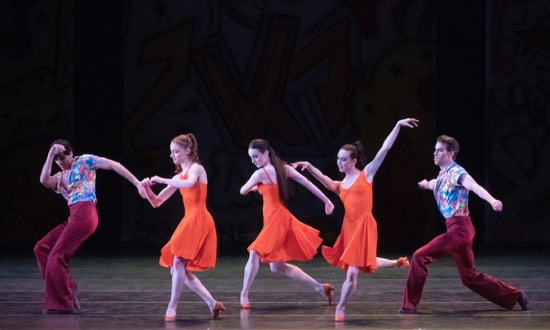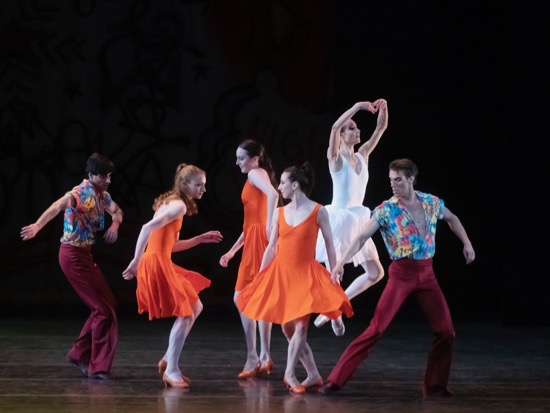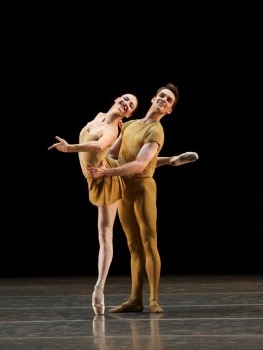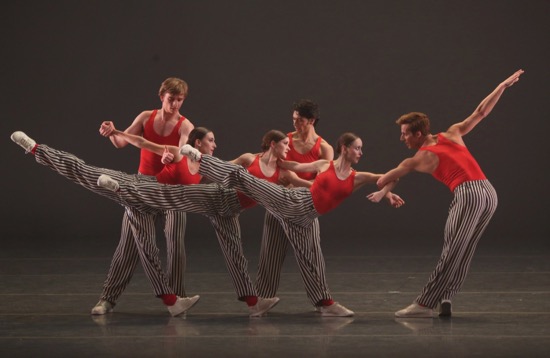American Ballet Theatre’s Tharp Trio at Lincoln Center, May 30-June 3

Does anyone dare to call Giselle dated? I doubt it. It’s a centuries-old classic that’s had numerous facelifts. I don’t often wish myself back at its premiere in 1832. However, feeling a twinge of nostalgia for something in your own not-so-distant past can be enriching when contemplating it anew. I wrote my review of Twyla Tharp’s Deuce Coupe in March of 1973 on a Hermes portable typewriter with a son not yet two years old sleeping (fingers crossed) in his crib. The work’s world premiere had taken place in Chicago on my birthday. When I saw its revival by American Ballet Theatre a few days ago on an all-Tharp program, at least two members of its original cast, Sara Rudner and William Whitener, were in the audience, as was its lighting designer, Jennifer Tipton. We all have mostly gray hair.
Robert Joffrey certainly made ballet history when he invited Tharp to make a piece for The Joffrey Ballet, but he may not have envisioned how it would turn out. Of its eighteen dancers, six (including the choreographer) were members of Tharp’s own company. Throughout the piece, guys who had joined together in United Graffiti Artists worked at the back of the stage, spray-painting onto three gradually-rolling-upward sheets of white paper the artwork with which they usually decorated subway cars and the sides of buildings. The music—fourteen songs recorded by The Beach Boys and compiled on tape by David Horowitz—included Horowitz’s own variations on the band’s “Cuddle Up.” Back in 1974, I didn’t know the term “surf rock,” nor could I relate the song “Little Deuce Coupe” to the 1932 Ford that could handily be turned into a hot rod. Deuce Coupe II and Deuce Couple III were far less memorable, since ballet companies couldn’t afford to hire Tharp’s company for every performance.
Quite a few Joffrey dancers turned up their noses and quit the cast during the 1970s rehearsals; chances are they’d never heard of thirty-two-year-old Tharp. This year, the two casts of ABT dancers learned the 2019 revival with gusto and perform it with apparent delight—indulging in the intricate complex of lazily slithering walks, loose springs into the air, slippery hips, twisting feet, lolling heads, swinging arms, and steps that suspend a moment or two off-balance, as if those doing them were loath to descend to earth. Remember the boogaloo? Remember the frug? Inhaling marijuana has never gone out of style. Yet bursts of speed and extreme accuracy pull the sensuous quality up short. In the cast I saw, principal dancers, such as Stella Abrera, who’s been in ABT since 1996, Misty Copeland, who joined in 2001, and James Whiteside, who became an ABT dancer seven years ago, joined soloists and corps de ballet members in what amounted to a zesty, wonderfully agile democracy.
When choreographing the ballet, Tharp—who’d been a brilliant, scrappy renegade ever since beginning her career—chose to link the ballet vocabulary to the kind of movement that the music incites. Threading through the Deuce Coupe I saw at Lincoln Center is Katherine Williams wearing pointe shoes and a white tunic. As the program indicates, she works her serene way through ballet steps alphabetically, beginning with Ailes de Pigeon and concluding some thirty minutes later with Temps lié through Voyagé. She exits at times, but mostly does her own thing in a corner or in the midst of dancers who wear orange dresses and medium-heeled shoes or Hawaiian shirts and red trousers (costumes adapted by Santo Loquasto from Scott Barrie’s originals). Very subtly, at moments throughout the piece, she seems to influence others, or to be influenced by them. Her ballet steps aren’t stiffly posed anyway, but flow along as if part of a deeper river.

Loquasto also designed the hanging panels that have replaced the paintings originally created during the piece (I can’t deny missing those street painters). And when Copeland performs the sensuous dream that is “Got to Know the Woman,” I recall the inimitable Rudner (who, with Tharp, Kara Chan, and Shawn Stevens staged the work) performing it 1973, but that’s a fleeting moment. I’m too busy relishing Abrera and Calvin Royal III dancing the opening duet, or Cassandra Trenary and Whiteside doing a stint, while K. Williams persists in her solitary ballet litany.
I like watching the nine dancers in “Alley Oop” being mildly apelike as, clustered, they sink down into loose-limbed, staggery, wide-legged steps. Or Luis Ribagorda, Cassandra Trenary (in Tharp’s role), and Tyler Maloney strutting across in a line, ignoring the Beach Boys’ instruction to “Take a Load Off Your Feet.” Or Trenary scrambling offstage after Stephanie Williams (originally tall Rosemarie Wright) in “Long Tall Texan.” In the song “Don’t Go Near the Water,” eight women (Catherine Hurlin, Virginia Lensi, Luciana Paris, Wanyue Qiao, Abrera, Davison, Trenary, and S. Williams) push their way across the stage only to be hurled back in various ways, while The Beach Boys sing an ecological warning (“Oceans, rivers, lakes and streams/ Have all been touched by man/ The poison floating out to sea/ Now threatens life on land”). During the lightly staccato, a cappella “Mama Says,” Erica Lall urges five guys to “Eat a lot sleep a lot brush ’em like crazy/ Run a lot do a lot never be lazy.”
In the end, the painted panels have lifted to reveal a cloudless sky. The dancers enter in a long, zigzag parade, the way they did for the opening number, “Little Deuce Coupe,” but this time, the music isn’t sprightly. Dennis Wilson, the Beach Boys’ pianist, plays his instrument and sings in a soft, almost wrecked voice the warm, slow song that he co-wrote: “The night has come/ Cuddle up to me/ Keep warm/ Mmm close to me.” The image is one of people helping, lifting up, traveling determinedly along, and, gradually, moving out of sight, with one fallen by the wayside and a few waiting beside her. The solo ballet dancer has ended her list with “Voyagé,” and they’re continuing their journey. Dated? Hardly.

ABT’s all-Tharp program began with The Brahms-Haydn Variations (2000), with Charles Barker leading the orchestra. Seeing the ballet twenty years later, as staged by Tharp and Susan Jones, I’m more aware of what fun Tharp must have had working with the tropes of classical ballet and, here and there, delicately undermining them. She had a veritable army at her bidding: Five principal couples, two slightly less major ones, and an ensemble of eight women and eight men charge through Brahms’s manipulation of Haydn’s assertive theme through eight variations and a finale that wraps fragments of everything into the theme’s triumphant emergence.
The ensemble doesn’t hang around much. Often, split in half, groups of dancers enter from either side of the stage to affirm classical symmetry for a while and then retreat. Nor does the corps de ballet state the music’s theme. That’s the job of the three leading couples (Misty Copeland and Joo Won Ahn, Luciana Paris and Gabe Stone Shayer, Hee Seo and Blaine Hoven the night I attended). Later, each pair also dominates a variation, but by “dominates,” I don’t mean walking onto the stage, assuming a position, and letting us admire them before they start dancing their pas de deux. Responding to what Tharp heard in the music, any of the dancers or group of dancers may echo someone’s pattern or explode out of it or enter and exit before you’ve fully grasped their role.
All, of course, dance with clarity and the conviction that they know what they’re doing, even if they’re (catch that split-second joke) unsure. Here a duet is flirtatious, here another is passionate (her head flung against his chest). Watch for Christine Shevchenko and Joseph Gorak, Sarah Lane and Gary Pogossian. They’ll be back. Ditto Rachel Richardson and Jose Sebastian, Betsy McBride and Duncan Lyle. The music can turn them loving or tempestuous. And they’re seldom alone. A line of women may decide to dance their way across the back of the stage. Someone may leave a group pattern, another may join. I imagine a party in which people decide whom to spend time with and whom to get away from. The displays of precise and elegant dancing, the good manners on the fly thread through one another. The lifts, the spins, the intricate rushes across space rarely stop; the music does only briefly. And when Brahms ends his variations with the expected triumphant flourish, every guest at this party doesn’t instantly rush to capitulate.

The evening that began with The Brahms-Haydn Variations ended with In the Upper Room. Tharp made it in 1986 for her company, Twyla Tharp Dance. When Mikhail Baryshnikov became American Ballet Theatre’s artistic director, and she became an artistic associate, seven members of her former company were absorbed into ABT; so the 1989 cast for In the Upper Room featured those Tharpists mixed with ABT dancers.
In the Upper Room took its title from a reference in the New Testament. In such a room, the twelve apostles gathered after the Crucifixion and perhaps earlier for the Last Supper. Tharp has always considered dancers as heroes. And in her masterwork (this iteration staged by Shelley Washington and Nancy Raffa) they too number twelve and are indeed heroic. When the curtain opens slowly to reveal billows of shifting mist, glowing in Tipton’s lighting, we might well be seeing a vision of empyrean heights.
In choreographing the piece, Tharp set out to contrast and mingle ballet and her kind of contemporary dance. The decision wasn’t one of expediency as it may have been with Deuce Coupe, and the costumes (originally designed by Norma Kamali) help make the differences clear. Everyone begins wearing light-weight, full cut black-and-white striped blouses, but the “contemporary” six wear long pants to match, red socks, and sneakers. The three women in the ballet sextet wear short skirts instead of pants, red socks, and red pointe shoes Over the course of the dance, costume elements may be shed; three men work bare-chested, three women are bare-legged in red leotards.
The recorded music by Philip Glass is unrelenting. It may sing out scraps of ecstatic melody—angel voices, but underneath, terse rhythms are always advancing, layering, changing pitch and sonority, inciting, steadying. The dancers appear out of the fog and disappear back into it as if pulled there. Stephanie Williams and Wanyue Qiao begin the work with a strenuous, springy prancing in place, and are almost immediately joined by three comrades in sneakers: Calvin Royal III, Duncan Lyle, and Cory Stearns.
I find one dance for the sneaker sextet especially exciting. They’re packed together in two lines—the three men together and the three women. Working vigorously, hanging onto each other or not, they make me think of a country dance gone crazy, and when the supported women collapse one by one, as if by accident, they’re almost on top of one another before they get hauled upright again. Royal, Lyle, and Stearns turn unison dancing into a marvel of athletic precision, springy but weighted.
Members of the ballet sextet tend to work in pairs (Erica Lall, Zimmi Coker, and Christine Shevchenko are partnered by Gary Pogossian, Arron Scott, and Joo Won Ahn), although once, Shevchenko dances with the support of all three guys. Nor are the two diverse squads always separate. When the six make their first appearance, Williams and Qiao (now joined by Catherine Hurlin and Brittany DeGrofft) continue to chug away behind them. Every now and then, two women on pointe thread rapidly through whatever else is happening on the stage. When the ballet men lift their women or assist them into spins on pointe, the moves seem unusually fluid; the women all but flower into positions.
Tharp’s approach to repetition isn’t like Glass’s. She repeats whole passages instead of small modules, altering them in the process. As Tipton’s lighting pierces the mist with diagonal beams, all that we’ve seen seems to reappear, compressed and piling up until the intensity becomes cataclysmic. Yet in the end, there are only two resilient women—side-by-side, stepping their way back into the fog and the sudden silence.
.

An invaluable review for its historical context and Deborah’s descriptive talents that put you in the theater with her, possibly sitting on her lap without obscuring her view. Terrific writing and I for one am grateful for it.
I am flabbergasted by your writing — and your ability to remember so much detail and sequence!
Thanks for your insightful review, Deborah.
This ABT performance marks the first time that Deuce Coupe and In the Upper Room have been performed together.
They are also the first and last premieres I danced in Tharp repertory.
What a rush of memories!
This review surges and flows like a river giving great clarity to all it touches. Remarkable.